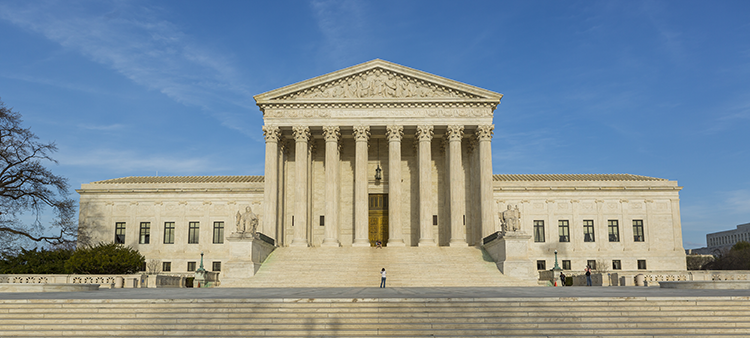Chemerinsky: A look back at the Supreme Court’s October 2018 term

Erwin Chemerinsky. Photo by Jim Block.
There was much that was unusual about the U.S. Supreme Court’s October 2018 term. The court began with only eight justices. There was the dramatic fight and narrow confirmation of Brett M. Kavanaugh. There was Justice Ruth Bader Ginsburg’s illness, which kept her off the bench for oral arguments in January and may explain why she wrote fewer majority opinions (six) than any other justice. The court was unusually slow in deciding cases: On June 20, a week before the end of the term, there were still 20 cases that had been argued awaiting decision. What should be gleaned from the term?
The divisive issues
When possible, the court seemed to be avoiding the most divisive issues. On Friday, Jan. 11, the justices met in their private conference to decide the remaining cases to take for the term. They had eight slots open on their April oral arguments calendar. They had an amazing array of cases to choose among:
• A 9th Circuit decision upholding a preliminary injunction against President Donald Trump’s rescission of the Deferred Action for Childhood Arrivals program;
• A split among the circuits as to whether sexual orientation in employment is sex discrimination in violation of Title VII;
• A 2nd Circuit case upholding a New York City ordinance greatly restricting the ability to have guns outside the home;
• A 7th Circuit case declaring unconstitutional an Indiana law that imposed restrictions on abortions;
• A request from the solicitor general to review preliminary injunctions by three federal district courts against Trump’s ban on transgender individuals serving in the military;
• And a New Jersey Supreme Court decision preventing cities from giving historic preservation funds to churches.
The court took none of them for this term. The most controversial cases taken this term were ones where the court had no choice—partisan gerrymandering, which it had to take because it is obligated to hear cases from three-judge federal district courts, and the census case regarding a better explanation of the Commerce Department’s decision to add a citizenship question to the 2020 census and the need for a fast resolution to allow census forms to be printed.
I think after the Kavanaugh hearings, the justices wanted a term with a lower profile—and overall, they succeeded in having fewer high-profile cases than usual on divisive issues.
Ideology of the court
The court was as divided as ever, but less so ideologically. There were 66 decisions with signed opinions, and 21 were resolved by a 5-4 margin (about the same as last year when it was 59 decisions and 19 were 5-4). But a year ago, in the October term, the five conservatives were together in the majority in 14 of the 19 total 5-4 decisions. This year, the five conservative justices were together in under half of the 5-4 decisions. The liberal justices were able to create majorities in many of these cases by attracting one of the conservatives to join them. For example, there were four decisions that were 5-4, with Justice Neil M. Gorsuch joining with Ginsburg, Stephen G. Breyer, Sonia Sotomayor and Elena Kagan. In Department of Commerce v. New York, Chief Justice John G. Roberts Jr. joined with the liberal justices to require that the Trump administration justify asking a question about citizenship on 2020 census forms.
Is this a reflection of the type of cases on the docket this term, or is it a harbinger for the future? It also is important to not treat all cases the same in assessing the ideology of the court. The conservative position prevailed on most of the issues traditionally defined by ideology, such as the death penalty (Bucklew v. Precythe), the separation of church and state (American Legion v. American Humanist Association), partisan gerrymandering (Rucho v. Common Cause), sovereign immunity (Franchise Tax Board of California v. Hyatt), and judicial protection of property rights (Knick v. Township of Scott, Pennsylvania).
2 justices speak up
It was a term where the voices of Kagan and Justice Clarence Thomas seemed especially important. Kagan wrote passionate dissents in the cases about partisan gerrymandering (Rucho) and the takings clause (Knick v. Township of Scott, Pennsylvania). She also wrote some of the more important majority opinions, such as in rejecting a challenge to a federal statute as being an excessive delegation of legislative powers (Gundy v. United States) and in striking down a provision of federal law that prevented registering a trademark that was “scandalous” or “immoral” (Iancu v. Brunetti). Perhaps because of Ginsburg’s illness, Kagan took on the role of being the most powerful liberal voice.
Thomas had a term in which he was more outspoken than ever about his desire to overrule landmark decisions. He wrote that Gideon v. Wainwright—which requires that state governments provide counsel to those who cannot afford it if they face possible prison sentences—was wrongly decided (Garza v. Idaho). He also urged the overruling of New York Times Co. v. Sullivan, which limits the ability of public officials to recover for defamation (McKee v. Cosby). He called for eliminating all substantive due process and protecting rights only under the privileges or immunities clause and only those that can be justified from an originalist perspective (Timbs v. Indiana). He has staked out a position as the far right of an overall conservative court.
Roberts’ court
It is the Roberts Court. I remember in September 2016 being part of a discussion about what it would be like if Hillary Clinton won, if Merrick Garland was confirmed, if and Roberts was frequently in dissent. But the election of Trump and the confirmations of Gorsuch and Kavanaugh mean that this is something that Roberts need not fear. In the nonunanimous cases, Roberts was the justice most often in the majority: 75% of the time.
The last of the day term also reflected how much it is the Roberts Court as Roberts wrote the majority opinion in the two most important decisions of the term, partisan gerrymandering and the census case.
Looking ahead to next term
Next year will be a blockbuster term. As the justices begin their summer recess, they already have granted review in 50 cases for next term, far more than at this stage in recent years. Cases on the docket involve controversial issues such as DACA, the Second Amendment, sexual orientation discrimination in employment, the Affordable Care Act, and government aid to parochial schools.
They will be decided in the midst of a presidential election year, so the justices’ desire for a lower profile is not going to last for long.



